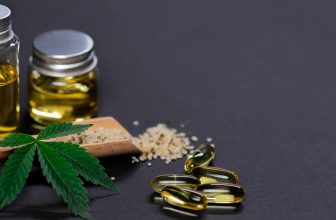Used for medicinal as well as recreational purposes, cannabis is consumed in a variety of ways. Some methods include smoking it in the form of a joint, vaping cannabis oils, dabbing concentrates, as well as ingesting it in the form of sublingual tinctures and edibles.
Regardless of the method for consuming cannabis, its important to understand the biphasic nature of cannabis and how THC tolerance can change your experience with cannabis over time.
Understanding cannabis tolerance and its biphasic properties can help you mange the quality of your cannabis experience. Whether you are a medical cannabis user that benefits from CBD or a recreational user that enjoys toking up to chill out, knowing how cannabis affects the body can help you determine when its time to take a break or adjust your dosage.
For regular cannabis users, they will inevitably develop a THC tolerance which causes smoking and vaping to become less effective.
By learning to manage THC and CBD levels or by taking a cannabis tolerance break, you can actually reverse tolerance and improve cannabis effects. When you bring down your weed tolerance, you can save money on weed because you won’t have to smoke as much to get the same amount of high.
What Are the Active Compounds in Cannabis?
or is a group of plants having psychoactive properties. It is mainly known for its three species: sativa, ruderalis and indica.
has around 483 compounds which include different cannabinoids, terpenoids, flavonoids, terpenes, and other compounds. Out of these compounds, cannabinoids are known to induce powerful mental and physical effects when consumed.
THC: The Primary Psychoactive Compound
Tetrahydrocannabinol or THC is the main psychoactive compound of cannabis. It is a mind-altering substance that binds to the cannabinoid receptors in the brain and body which gives you the feeling of a ‘high’.
CBD: The Non-intoxicating Psychoactive Compound
Cannabidiol or CBD is the non-intoxicating psychoactive compound known for its medical benefits. It relieves pain, anxiety, and induces sleep in the user without the high. In 2018, CBD was FDA-approved to treat epilepsy, a neurological disorder.
Biphasic Properties of CBD
Cannabidiol (CBD) is biphasic in nature. This means it has different effects on the body at different concentration levels in the blood.
At low doses (10mg-100mg), CBD works as a stimulant that increases alertness and makes you more responsive towards your surroundings. You may feel more energetic and less fatigued.
At high doses (300mg-600mg), CBD has sedating effects on the body. It may help to calm your mind down and can help you fall asleep. Using CBD, may help you say goodbye to all those sleepless nights.
This biphasic effect can also affect anxiety. Lower doses of CBD produce an anxiolytic effect to reduce anxiety issues in the user. But the same does not hold true for higher doses and thus it may not be suitable to treat anxiety effectively at this dosage.
What is Cannabis Tolerance?
If you consume cannabis regularly and in large quantities, you develop a tolerance towards it. When this happens, the effects of cannabis dissipates after repeated use. To attain a consistent state of euphoria, the dosage will have to increase.
We build up tolerance as a reaction to the different receptors in the body. The THC compound of Cannabis affects cannabinoid type 1 (CB1) receptors in the brain.
Repeated activation of CB1 receptors leads to desensitization, a process of weakening of the response to THC. After this, internalization takes place, where the CB1 receptors are removed from the cell surface. Therefore, you will need to consume more THC to get high.
According to medsignals.com, tolerance levels can vary depending on the frequency of cannabis consumption, its strength, the user’s age, individual body chemistry, as well as method of consumption.
Cannabis Tolerance with Vaping
As you vape a cannabis strain with THC more frequently, the effects it has on your brain and body decrease over time. Therefore, you need to take a higher dose of the strain to feel the same effects. This dependence tends to reduce your response to cannabis and the phenomenon is known as tolerance. This can happen with vaping more rapidly than traditional smoking methods.
Cannabis comes in different forms and can be consumed via different methods. It, therefore, produces varied effects at different forms and consumption methods.
Most common cannabis strains only contain around 17%-28% THC. Approximately 0.66 grams of marijuana per joint are burned off which only provides around 0.11mg of THC per joint.
For instance, when smoking cannabis flower in the form of a joint, you’re typically consuming lower concentrations of THC than if you were to vape a cannabis oil. Not only are most of the active compounds in cannabis lost due to combustion when you smoke, but vapes, on the other hand, can also contain significantly higher concentrations of active cannabinoids to begin with.
Most common cannabis strains only contain around 17%-28% THC. Approximately 0.66 grams of marijuana per joint are burned off which only provides around 0.11mg of THC per joint.
However, one gram of high concentration THC oil in a vape will give you a more potent hit, inhaling almost 1mg per toke. Therefore, you’re more likely to build tolerance faster in the case of vaping as you’re consuming high levels of THC in a shorter period of time as opposed to other methods of consumption.
Having said that, a tolerance to vaping doesn’t necessarily build up your tolerance for consuming cannabis by other means like edibles or absorbing tinctures. Every method of cannabis consumption has its own tolerance depending on the potency, bioavailability, and effects.
Understanding CBD Tolerance
Unlike THC, Cannabidiol is not a tolerance-forming compound. It rather works in the opposite direction in your body. With the passage of time, the CBD dosage that a user consumes reduces significantly.
Whereas THC binds to the cannabinoid receptors and due to repeated interaction, it reduces their effectiveness. Thus, desensitizing the cellular receptors and resulting in pharmacodynamic tolerance.
CBD acts as a receptor antagonist at CB1. It inhibits the psychotic effects of THC. This helps maintain the sensitivity of receptors and promotes the increased activity at the receptors.
CBD also increases the number of endogenous cannabinoids like anandamide in the body by blocking the enzymes that cause their breakdown. It thus enhances the endocannabinoid signaling within our body. Eventually, this helps in maintaining a balance (homeostasis) in the endocannabinoid system (ECS).
This further means that the body requires less CBD to achieve the desired effects over time. Therefore, it isn’t able to develop a tolerance towards CBD.
How to Reset Your Cannabis Tolerance?
When you become highly tolerant of cannabis, you may have to start taking breaks from consuming cannabis to reverse the tolerance. If you feel that you have to consume larger amounts of cannabis to get the same high effects, you should take tolerance breaks or T breaks to reset your cannabis tolerance. This break means full abstinence from smoking and vaping cannabis for a few days or even weeks.
Although increased consumption of THC reduces the effects on the CB1 receptors, they can recover and return to the normal levels over time. A 2016 study showed that with at least two days of abstinence, users start to lose their tolerance. Your body gets cleared up from residual cannabinoids, especially THC, and the psychoactive effects return with full potency. It’s worth noting that permanent THC detox can take weeks if done after prolonged heavy use.
Avoiding Cannabis Tolerance
To avoid building up a cannabis tolerance altogether, you can try out the following methods:
Micro-dosing: Less is More
You are less likely to develop a cannabis tolerance if you monitor your doses. The more you smoke, the less high you get over time. Take low doses and stop as soon as you achieve the desired effects.
Vape High CBD Strains
CBD doesn’t activate the CB1 receptors and thereby avoids building a tolerance. Try to use cannabis strains with a higher CBD-to-THC ratio. Although some people have reported a subtle mind-altering effect on CBD consumption, it’s not nearly as intense or impairing as THC and for the most part, is widely considered safe. Moreover, CBD eases pain and anxiety along with promoting your overall health.
Conclusion
Although Cannabis is still an illicit drug under federal law, we cannot ignore the benefits of compounds like CBD. One only needs to keep in mind that tolerance buildup can happen with THC.
To avoid this, consumers are advised to rather go for CBD products given its proven positive interaction with the endocannabinoid receptors. You may need to experiment a little to figure out the correct dosage of CBD. It’s safe to do so as our bodies don’t form a tolerance towards CBD.
Being biphasic in nature, CBD can either act as a stimulant or a sedating compound. It all depends on its concentration levels in the blood. This is an important trait to be kept in mind as a proper and effective dosage is key to consuming cannabis safely. Hence, consult a doctor before using cannabis for medical purposes.
Educating yourself in terms of the usage and working of Cannabis strains is important for your own wellness and peace of mind. We hope this article helped you on your cannabis journey, and that you find your wellness within.




